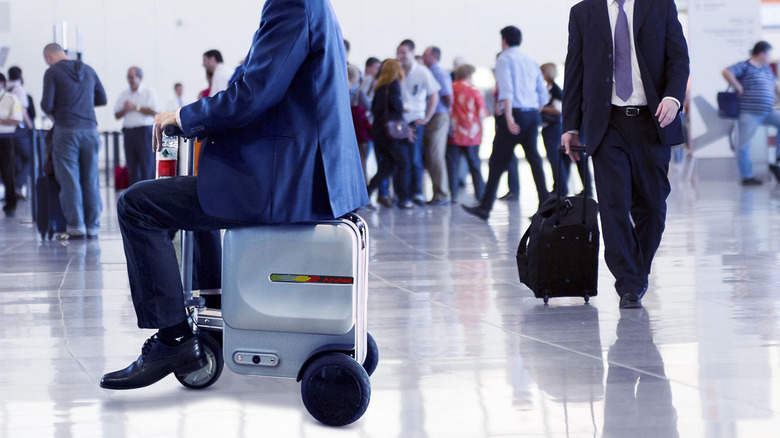Why You Need To Think Twice Before Bringing Rideable Motorized Luggage To The Airport
It's a scooter! It's a bag! It's ... rideable luggage? Yes, motorized suitcases have hit the market, and travelers can now straddle their hard-shell containers and ride them down the airport concourse. There are two major pioneers in this futuristic new industry: Airwheel, founded in 2004 and headquartered in China, and Modobag, which was started in Chicago in 2016. "Smart luggage" is a still a new concept to most people, and here we're referring to cases that double as a personal vehicle. These aren't intended for joyrides on the highway, but both brands are shockingly swift: Airwheel reaches a top speed of 8 mph, while Modobag can reach 7 mph, about as fast as most kids pedal with training wheels — and far faster than anybody walks.
At first glance, smart luggage may look and sound ridiculous, a sign that travelers are lazier than ever. But they're extremely handy for folks with mobility issues, especially in extra-large airports that require passengers to schlep long distances to their next gate. They're also just fun to ride, adding a little whimsy to the otherwise grueling airport experience. Still, before you fork over $1,495 for a new Modobag, you should know the hesitations — and policies — airlines have about taking this luggage aboard. Misusing smart luggage may turn out to be one of the mistakes to avoid if you're new to traveling by plane.
The lithium battery question
Rest assured that there's nothing wrong with the Airwheel or Modobag itself. The weight and dimensions are perfect for checked baggage, and both Modobag and Airwheel models are designed to serve as carry-on as well. This alone is an impressive feat of engineering: creating a bag that is large enough to ride but also small enough to fit in an overhead compartment. If it came down to specs, both brands would pass inspection with flying colors. This will come as a relief, given how easily bulky luggage can cause a flight delay.
The main problem is the lithium battery, which is a growing conundrum in the electronics-obsessed travel sector. Phones and power banks run on lithium batteries, and they usually pass muster; even drones are permitted on airplanes, provided batteries are kept in carry-on bags. There is a contentious debate about whether e-bikes can be transported on planes, and each airline has different policies on the matter, all having to do with its hefty power supply. The likelihood that a lithium battery will spontaneously combust is incredibly low, and it's not something airline passengers should lose any sleep over. But if a lithium battery did ignite, the fire could cause spectacular damage, and the self-oxidizing conflagration would be nearly impossible to put out.
Safety in the crowded airport
The battery shouldn't cause any problems inside most airports, but not every traveler takes kindly to smart luggage. Some airports have objected to the tiny vehicles careening through crowds, especially given their unlikely speeds. Terminals can get very crowded, with travelers camped out on the floor and other electric vehicles driving down the corridors. Tensions may run high at peak hours, and the last thing people want is to get run over by a speeding valise. In Japan, for example, smart luggage is considered a "motorized bicycle" and must be registered.
In short, if airport staff asks you to dismount your smart luggage and pull it behind you, just acquiesce. Nobody's going to jail, and it's easy enough for most people to step off and walk — or at least find another conveyance. As smart luggage becomes more popular, using it properly in different spaces may become one of many unspoken airplane etiquette rules.
A (usually) simple solution
As for the battery issue, how do you make the airlines happy? The solution is generally pretty simple: Just remove your lithium-ion battery from the smart luggage and take it with you on the plane. If you're using your smart luggage as carry-on, you don't need to futz with the battery at all. The argument goes like this: If your store your bag in the cargo hold, there's nothing anyone can do in the event of an emergency. A carry-on bag is at least accessible to in-flight staff, who are trained for a wide range of emergencies, including firefighting. Again, there's no reason to wring your hands over this possibility.
That said, it's important to confirm with your specific airline that smart luggage is permitted aboard. TSA and individual airline policies don't always align, and the rules around newfangled technology like smart luggage may cause confusion when you arrive. These are pricey investments, and even in the worst case scenario, airport staff won't let you just abandon your high-tech suitcase in the lobby. While you're prepping, here are the best tips to avoid getting flagged by TSA.



